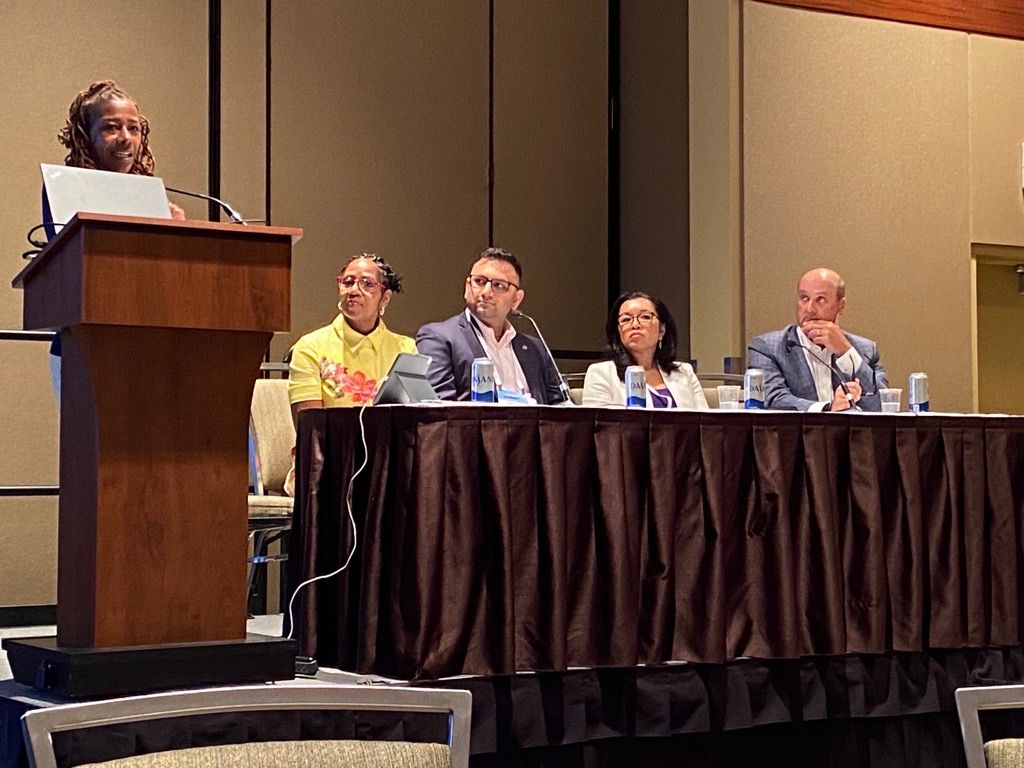In health equity efforts, trust can be hard to gain, but it’s easy to lose
Health equity leaders at several hospitals discuss the work to close disparities in outcomes, engage communities, and the need to try new strategies.
Hospital leaders discuss ways to improve health equity during the American Hospital Association Leadership Summit in July. (Photo: Ron Southwick)

Hospital leaders focused on improving health equity in their patient populations know that it’s going to take a great deal of time and effort.
Joy Lewis, senior vice president of health equity strategies for the American Hospital Association, describes it as “generational work.”
“It’s the long game,” Lewis says. And it’s a sentiment she repeated at the AHA Leadership Summit in Seattle last month.
Health equity emerged as one of the leading themes of the conference. Lewis led a panel of hospital leaders who discussed their efforts at improving health equity in their communities.
The leaders on the panel repeatedly stressed the importance of building trust with their communities, particularly among their underserved patient populations. They also highlighted the need to employ new strategies, fostering an organization-wide commitment, and staying the course in the face of setbacks.
Mark Lodes serves as chief medical officer for population health and medical education at the Froedtert & the Medical College of Wisconsin health network. Lodes and other members talked about the importance – and fragility – of community trust.
“I think trust is earned. It’s much easier to lose a community or an individual’s trust than it is to gain it,” Lodes says.
Rosalyn Carpenter is senior vice president for diversity and inclusion and chief diversity officer for CommonSpirit Health. Carpenter says engaging the community is key in building trust.
“We establish trust by showing up, by walking that talk,” Carpenter says.
Part of that effort involves closely analyzing data, from the impact of charitable donations and how they are used to supplier diversity, among a host of other measures. “This would not only enable us to tell our story, but it becomes a measure of accountability,” she says.
Erfan Karim, executive director of ExpressCare at NYC Health+Hospitals in New York City, says the system makes concerted efforts to utilize small businesses, including minority-owned businesses.
“Working to drive those dollars to the community members to the minority owned businesses is a big deal,” he says.
Karim also points to NYC Health+Hospitals giving jobs to many of those in the surrounding community.
“I think that makes a huge difference, hiring from the community and actually making them a part of the health system,” he says. “That's how we build trust.”
“We invested in 200 community health workers recently,” he adds. “That enables community members to work for us to become credible messengers and enable success.”
Celina Cunanan, chief diversity, equity & belonging officer at University Hospitals in Cleveland, talked about how the system engaged with community members before building a health center for women and children.
University Hospitals convened a community advisory board in developing the center, which was crucial in helping develop a facility to address a wide range of needs. The advisory board played a key role in building trust in the community and developing a center that met the needs of neighbors.
"They advised us on what they wanted to see," she says.
“We have vision, we have dental, pharmacy, we have social needs navigation,” Cunanan says. “We have legal aid, we have dentistry. We have a nutritionist, we have lactation. Everything's embedded here.”
The healthcare leaders also discussed taking unconventional approaches to improving health equity and being willing to try new strategies.
- Read more: Health equity ‘can’t be a side hustle’
Froedtert partnered with a barbershop to operate a wellness clinic to offer free health screenings, Lodes says. He says it was an effort to reach African-American men that are reluctant to go to physicians or clinics.
Looking at its data, Froedtert found a 5-10% gap among underserved communities in screening for colon cancer, flu vaccine, diabetes management and other conditions. Froedtert sent out thousands of stool kits and 27% were returned, which helped close the gap in cancer screenings.
But as Lodes says, “For every one of those successes we have, we have about two or three failures.”
Froedtert organized a breast cancer screening event, which was fully booked, Lodes says. But only 30% of those who scheduled appointments actually showed up.
“This is really hard work,” Lodes says. “We’re learning as we go.”
Carpenter stresses the importance of backing from hospital executives and boards to sustain health equity efforts, and she lauded the backing from CommonSpirit.
“Our board and our C-suite is very much committed to this work and supportive of our office of diversity, and inclusion,” she said, adding, “Health equity is an organizational commitment.”
CommonSpirit has designated health equity liaisons in each hospital, Carpenter says.
Given the difficulty involved in health equity initiatives, Carpenter and other hospital leaders reinforced the importance of staying the course and striving to close disparities in outcomes. She also highlighted the need to embed best practices in health equity throughout the organization.
“Keep pushing,” Carpenter says. “I don't think that we will ever work ourselves out of business here. There will always be inequities to address.”
Read more:
Telehealth faces a looming deadline in Washington | Healthy Bottom Line podcast
February 12th 2025Once again, the clock is ticking on waivers for telemedicine and hospital-at-home programs. Kyle Zebley of the American Telemedicine Association talks about the push on Congress and the White House.